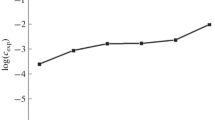Abstract
The analytical methods mass spectrometry, UV/Vis, IR, Raman, Fluorometry, XRD, Mössbauer, and NMR used to elucidate chemical structure are evaluated regarding their capabilities to be used as primary analytical techniques in quantitative measurements, considering the criteria in the CCQM definition of primary methods. This includes a review of the respective measurement equations, the evaluation of the measurement uncertainty, and a discussion of evidence for the “highest metrological level”, as obtained from intercomparisons in contest with other methods. It is shown that only few methods fulfill the CCQM criteria. Quantitative NMR spectroscopy is one of them and may be considered as a potential primary method as recommended by CCQM because of being free of empirical factors in the uncertainty budget.
Similar content being viewed by others
Notes
In the paper mentioned here [29] confusion arises with the formulas used to calculate the purity. It should be noted that the purity P and the purity factor f should be distinguished. Otherwise somewhere a factor of 100 is wrong as for instance in Eqs. 3 and 6. We would recomend to use the accepted symbols [30].
References
Jancke H (1998) CCQM Rep 98:1–12
Jancke H (1998) Nachr Chem Tech Lab 46:720–722
Richter W (1997) Accred Qual Assur 2:354–359
EURACHEM/CITAC Guide (2003) Traceability in chemical measurement, 1st edn. www.eurachem.ul.pt
Milton MJT, Quinn TJ (2001) Metrologia 38:289–296
Quinn TJ (1997) Metrologia 34:61–65
Taylor AJ, Linforth RST (2003) Int J Mass Spectrom 223–224:179–191
De Bievre P, Peiser HS (1997) Fresenius J Anal Chem 359:523–525
Rouessac F, Rouessac A (2000) Chemical analysis. Wiley, Chichester, New York, Weinheim, Brisbane, Singapore, Toronto (English edition)
Kontoyannis CG, Bourpoulos NC, Koutsoukos PG (1997) Vibrat Spectrosc 15:53–60
Belozerski GN (2000) Mössbauer spectroscopy, applications. In: Lindon JC, Tranter GE, Holmes JL (eds) Encyclopedia of spectroscopy and spectrometry. Academic Press, San Diego, San Francisco, New York, Boston, London, Sydney, Tokyo, pp 1324–1334
Favre M, Landoldt D, Hoffman K, Stratmann M (1998) Corros Sci 40:793–803
Klug HP, Alexander LE (1974) X-ray diffraction procedures for polycrystalline and amorphous materials. Wiley, New York, London, Sydney, Toronto
Suryanarayanan R (1990) Powder Diff 5:155–159
Campbell Roberts SN, Williams AC, Grimsey IM, Booth SW (2002) J Pharm Biomed Anal 28:1149–1159
Hill RJ (1993) Data collection strategies, Appendix 5.A. In: Young RA (ed) The Rietveld method, IUCr monographs on crystallography. Oxford University Press, Oxford, pp 95–101
Günther H (1995) NMR spectroscopy. Wiley, Chichester
Freeman R (1988) A handbook of nuclear magnetic resonance. Longman Scientific, Harlow
BIPM, IEC, IFCC, ISO, IUPAC, IUPAP, OIML (1993) Guide to expression of uncertainty in measurement, 1st edn. Corrected and reprinted in 1995
Hibbert DB (2003) Accred Qual Assur 8:195–199
International Union of Pure and Applied Chemistry (1999) Pure Appl Chem 71:1593–1607
Antignac J-P, Le BizecB, Monteau F, Andre F (2003) Anal Chim Acta 483:325–334
Peplinski B, Schultze D, Wenzel J (2001) Mater Sci Forum 378–381:124–131
Griffiths L, Irving AM (1998) Analyst 123:1061–1068
Maniara G, Rajamoorthi K, Srinivasan R, Stockton GW (1998) Anal Chem 70:4921–4928
Wells RJ, Cheung J (2001) The chemistry preprint server CPS: analchem/0103002
Wells RJ, Hook JM, Al-Deen TS, Hibbert DB (2002) J Agric Food Chem 50:3366–3374
Al-Deen TS, Hibbert DB, Hook JM, Wells RJ (2002) Anal Chim Acta 474:125–135
Al-Deen TS, Hibbert DB, Hook JM, Wells RJ (2004) Accred Qual Assur 9:55–63
Cvitas T (1996) Metrologia 33:35–39
Al Deen TS (2002) Validation of quantitative nuclear magnetic resonance (QNMR) spectroscopy as a primary ratio analytical method for assessing the purity of organic compounds: a metrological approach. Dissertation, University of New South Wales, Sydney, Australia
Malz F (2003) Quantitative NMR-Spektroskopie als Referenzverfahren in der analytischen Chemie. Dissertation, Humboldt-Universität zu Berlin, Berlin, Deutschland; http://edoc.hu-berlin.de/dissertationen/malz-frank-2003-06-30/PDF/Malz.pdf
Deubner R (2004) Quantitative NMR Spektroskopie zur Reinheits bestimmung von Arzneistoffen. Dissertation, Bayerische Julius-Maximilians-Universität Würzburg, Deutschland; http://opus.bibliothek.uni-wuerzburg.de/opus/volltexte/2004/836/pdf/Dissertation_Deubner.pdf
Ottner F, Gier S, Kuderna M, Schwaighofer B (2000) Appl Clay Sci 17:223–243
Alexander TG, Koch SA (1967) J Assoc Off Agric Chemists 50:676–678
Acknowledgement
The authors thank the Federal Ministry of Economics and Labour (BMWA), the German Federation of Industrial Cooperative Research Associations “Otto von Guericke” (AiF) and the German Research Association of Medicine Manufacturers (FAH) for supporting this work within the project AiF-No. 13843 N/1.
Author information
Authors and Affiliations
Corresponding author
Rights and permissions
About this article
Cite this article
Jancke, H., Malz, F. & Haesselbarth, W. Structure analytical methods for quantitative reference applications. Accred Qual Assur 10, 421–429 (2005). https://doi.org/10.1007/s00769-005-0004-9
Received:
Accepted:
Published:
Issue Date:
DOI: https://doi.org/10.1007/s00769-005-0004-9




